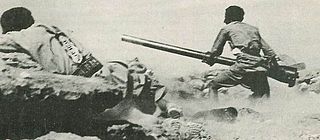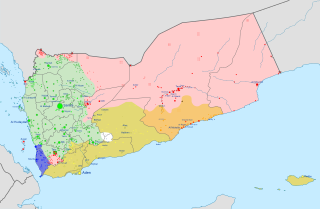
The Yemeni Armed Forces are the military forces of the Republic of Yemen. They include the Yemeni Army, Yemeni Navy and the Yemeni Air Force. The capital of the country, Sana’a is where the military is headquartered. Per the constitution of Yemen, the President of Yemen serves as the commander-in-chief.

Yemen, officially the Republic of Yemen, is a sovereign state in West Asia. Located in the southern Arabian Peninsula, it borders Saudi Arabia to the north, Oman to the northeast, and the Indian Ocean to the south, sharing maritime borders with Eritrea, Djibouti and Somalia across the Horn of Africa. Covering roughly 528,000 square kilometres, with a coastline of approximately 2,000 kilometres, Yemen is the second largest country on the Arabian Peninsula. Sanaa is its constitutional capital and largest city. Yemen's estimated population is 34.7 million, mostly Arab Muslims. It is a member of the Arab League, the United Nations, the Non-Aligned Movement and the Organisation of Islamic Cooperation.

The Yemen Arab Republic, commonly known as North Yemen or Yemen (Sanaʽa), was a country that existed from 1962 to 1990 in the northwestern part of what is now Yemen. Its capital was at Sanaa. It united with the People's Democratic Republic of Yemen on 22 May 1990 to form the current Republic of Yemen.

South Yemen, officially the People's Democratic Republic of Yemen, officially abbreviated to Democratic Yemen, was a state that existed from 1967 to 1990 as the only communist state in the Middle East and the Arab world. It was made up of the southern and eastern governorates of the present-day Republic of Yemen, including the island of Socotra. It was bordered by North Yemen to the North-West, Saudi Arabia to the North, and Oman to the East.

The North Yemen civil war was a civil war fought in North Yemen from 1962 to 1970 between partisans of the Mutawakkilite Kingdom and supporters of the Yemen Arab Republic. The war began with a coup d'état carried out in 1962 by revolutionary republicans led by the army under the command of Abdullah as-Sallal. He dethroned the newly crowned King and Imam Muhammad al-Badr and declared Yemen a republic under his presidency. His government abolished slavery in Yemen. The Imam escaped to the Saudi Arabian border where he rallied popular support from northern Zaydi tribes to retake power, and the conflict escalated rapidly to a full-scale civil war.

Yemeni unification took place on May 22, 1990, when the People's Democratic Republic of Yemen was united with the Yemen Arab Republic, forming the Republic of Yemen.

The Yemeni Air Force is the air operations branch of the Yemeni Armed Forces. Numbers of aircraft can not be confirmed but serviceability of these aircraft is low. Aircraft have been acquired by donations from other countries supporting either the Soviet Union or the United States during the Cold War. However, most of the air force was destroyed by airstrikes during the Saudi Arabian-led intervention in Yemen.

The modern history of Yemen began with the withdrawal of the Ottoman Empire. In 1839 the British set up a protective area around the southern port of Aden and in 1918 the northern Kingdom of Yemen gained independence from the Ottoman Empire. North Yemen became a republic in 1962, but it was not until 1967 that the British Empire withdrew from what became South Yemen. In 1970, the southern government adopted a communist governmental system. The two countries were officially united as the Republic of Yemen on May 22, 1990.

Military aircraft insignia are insignia applied to military aircraft to visually identify the nation or branch of military service to which the aircraft belong. Many insignia are in the form of a circular roundel or modified roundel; other shapes such as stars, crosses, squares, or triangles are also used. Insignia are often displayed on the sides of the fuselage, the upper and lower surfaces of the wings, as well as on the fin or rudder of an aircraft, although considerable variation can be found amongst different air arms and within specific air arms over time.
The Arab Cold War was a political rivalry in the Arab world from the early 1950s to the late 1970s and a part of the wider Cold War. It is generally accepted that the beginning of the Arab Cold War is marked by the Egyptian revolution of 1952, which led to Gamal Abdel Nasser becoming president of Egypt in 1956. Thereafter, newly formed Arab republics, inspired by revolutionary secular nationalism and Nasser's Egypt, engaged in political rivalries with conservative traditionalist Arab monarchies, influenced by Saudi Arabia. The Iranian Revolution of 1979, and the ascension of Ayatollah Ruhollah Khomeini as leader of Iran, is widely seen as the end of this period of internal conflicts and rivalry. A new era of Arab-Iranian tensions followed, overshadowing the bitterness of intra-Arab strife.
The al-Wadiah War was a military conflict which broke out on 27 November 1969 between Saudi Arabia and the People's Republic of South Yemen (PRSY) after disputes for the town of al-Wadiah on the PRSY-Saudi Arabian border. The conflict ended on 6 December when Saudi forces captured al-Wadiah.

The NDF Rebellion was an uprising in the Yemen Arab Republic by the National Democratic Front, under Yahya Shami, between 1978 and 1982.

The Second Yemenite War was a short military conflict between the Yemen Arab Republic and the People's Democratic Republic of Yemen. The war developed out of a breakdown in relations between the two countries after the president of North Yemen, Ahmad al-Ghashmi, was killed on 24 June 1978, and Salim Rubai Ali, a moderate Marxist who had been working on a proposed merger between the two Yemens, was murdered two days later. The hostility of the rhetoric from the new leadership of both countries escalated, leading to small-scale border fighting, which then in turn escalated into a full-blown war in February 1979.

The Yemeni civil war is an ongoing multilateral civil war that began in late 2014 mainly between the Rashad al-Alimi-led Presidential Leadership Council and the Mahdi al-Mashat-led Supreme Political Council, along with their supporters and allies. Both claim to constitute the official government of Yemen.

On 26 March 2015, Saudi Arabia, leading a coalition of nine countries from West Asia and North Africa, launched an intervention in Yemen at the request of Yemeni president Abdrabbuh Mansur Hadi, who had been ousted from the capital, Sanaa, in September 2014 by Houthi insurgents during the Yemeni Civil War. Efforts by the United Nations to facilitate a power sharing arrangement under a new transitional government collapsed, leading to escalating conflict between government forces, Houthi rebels, and other armed groups, which culminated in Hadi fleeing to Saudi Arabia shortly before it began military operations in the country.

Iran and Saudi Arabia are engaged in an ongoing struggle for influence in the Middle East and other regions of the Muslim world. The two countries have provided varying degrees of support to opposing sides in nearby conflicts, including the civil wars in Syria and Yemen; and disputes in Bahrain, Lebanon, Qatar, and Iraq. The struggle also extends to disputes or broader competition in other countries globally including in West, North and East Africa, South, Central, Southeast Asia, the Balkans, and the South Caucasus.

Algeria has an embassy in the Qatari capital Doha. The Algerian ambassador is Mustafa Boutoura. Qatar has an embassy in Algiers. The Qatari ambassador is Abdulaziz Ali Al Naama.

The UAE and Yemen have a complex and strained relationship, as the UAE has played a significant role in regional politics in Yemen, and has at various points been an adversary of the country, as the UAE's involvement in Yemen, for example the United Arab Emirates takeover of Socotra, and its support for the Southern Transitional Council, a secessionist organization in Southern Yemen, has been a source of tension between the two countries, and has contributed to the ongoing conflict and humanitarian crisis in the country. Furthermore, the UAE has been involved in other efforts in Yemen that have been controversial. The country has been accused of backing local militias and separatist groups that have sought to gain more autonomy or independence from the central government. Some critics have accused the UAE of using these groups to further its own interests in the region, rather than working towards a broader peace and stability in Yemen.















